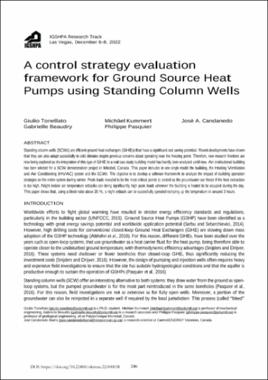| dc.contributor.author | Tonellato, Giulio | |
| dc.contributor.author | Kummert, Michael | |
| dc.contributor.author | Candanedo, Jose A. | |
| dc.contributor.author | Beaudry, Gabrielle | |
| dc.contributor.author | Pasquier, Philippe | |
| dc.contributor.other | IGSHPA Research Track (2022) | |
| dc.date.accessioned | 2022-12-04T22:07:39Z | |
| dc.date.available | 2022-12-04T22:07:39Z | |
| dc.date.issued | 2022 | |
| dc.identifier | oksd_igshpa_2022_tonellato | |
| dc.identifier.uri | https://hdl.handle.net/11244/336849 | |
| dc.description.abstract | Standing column wells (SCWs) are efficient ground heat exchangers (GHEs) that have a significant cost saving potential. Recent developments have shown that they can also adapt successfully to cold climates despite previous concerns about operating near the freezing point. Therefore, new research frontiers are now being explored as the integration of this type of GHE to a real case study building model has hardly been analyzed until now. An institutional building has been selected for a SCW demonstration project in Mirabel, Canada. This paper includes in one single model the building, the Heating Ventilation and Air Conditioning (HVAC) system and the SCWs. The objective is to develop a software framework to analyze the impact of building operation strategies on the entire system during winter. Peak loads revealed to be the most critical points to control as the groundwater can freeze if the heat extraction is too high. Night indoor air temperature setbacks can bring significantly high peak loads whenever the building is heated to be occupied during the day. This paper shows that, using a bleed ratio above 20 %, a night setback can be successfully operated ramping up the temperature in around 3 hours. | |
| dc.format | application/pdf | |
| dc.language | en_US | en_US |
| dc.publisher | International Ground Source Heat Pump Association | |
| dc.rights | In the Oklahoma State University Library's institutional repository this paper is made available through the open access principles and the terms of agreement/consent between the author(s) and the publisher. The permission policy on the use, reproduction or distribution of the article falls under fair use for educational, scholarship, and research purposes. Contact Digital Resources and Discovery Services at lib-dls@okstate.edu or 405-744-9161 for further information. | |
| dc.title | Control strategy evaluation framework for ground source heat pumps using standing column wells | |
| osu.filename | oksd_igshpa_2022_tonellato.pdf | |
| dc.identifier.doi | 10.22488/okstate.22.000038 | |
| dc.type.genre | Conference proceedings | |
| dc.type.material | Text | |
